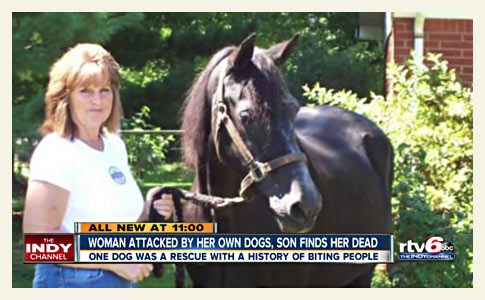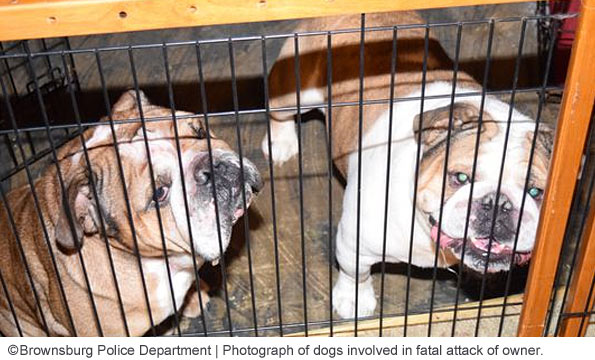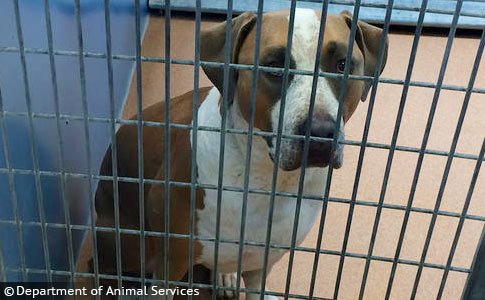
South Dallas home with a history of complaints where the suspected dogs resided.
DNA Results Explained
UPDATE 02/02/17: On October 31, 2016 the Dallas Police Department announced that no criminal charges would be filed in connection to the dog mauling death of Antoinette Brown. Police did not explain the DNA results. They simply stated, “the samples submitted did not contain DNA evidence that would link the animals that were suspected of the attack.” Fox 4 News then filed an extensive Open Records Request to obtain the entire case file, including the DNA test results.
The Fox 4 News investigation revealed that no nuclear DNA, which can identify an individual dog, and is a necessity in proving “guilt beyond a reasonable doubt” in a trial, was present in the three hairs tested by the California lab. Mitochondrial DNA, which can only determine maternal lineage or species type, was only present in two of the hairs and both had the same mitochondrial haplotype. The lab concluded that only 2% of the dog population contained this same haplotype.
Of the suspected dogs (“Quarantine Dog”), 5 of 7 tested positive for this haplotype, 71%. Of the unsuspected dogs, 2 of 9 tested positive, 22%.
Police abandoned the criminal charges due to the lack of nuclear DNA present. The mitochondrial DNA results could have been strengthened, according to the lab, if a “representative sampling of dogs from the victim’s neighborhood” had been taken. For instance, if only 2% of the dogs in Brown’s neighborhood matched, it could be assumed that 98% of the dogs could be ruled out. Since a representative sampling was never performed, this percentage will never be known.
The death of Brown is further complicated by a 10-hour delay in processing the scene that had been drenched in rain, during and after the attack. One detective said: “It had poured down rain, so the field was literally a swamp.” From the victim’s clothing found strewn across the muddy field, only three hairs found were “worth testing.” Further, the dogs were not seized by authorities until four days after the attack, whereby reducing the ability to detect human blood on the dogs.
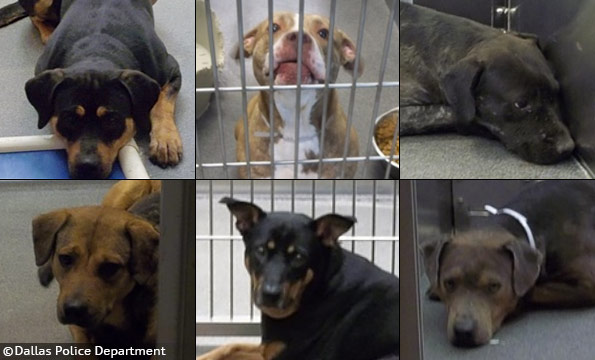
Six of the seven dogs seized four days after the deadly mauling of Antoinette Brown in May.
Related lawsuits:
Ward v. City of Dallas, Maria Cardoso, et al., No. DC-18-05856, Dallas County (05/03/2018)
Ward v. City of Dallas, Maria Cardoso, et al., No. 3:18-CV-1574-L, (N.D. Tex. Nov. 30, 2020)
10/31/16: No Criminal Charges
The Dallas Police Department announced today there will be no criminal charges filed in the dog mauling death of Antoinette Brown last May. Forensic tests from two separate labs could not establish a DNA link between Brown and the multiple dogs suspected of fatally attacking her. No eyewitnesses could identify which dogs were involved either. The seven suspected dogs had been involved in numerous previous incidents, according to a report issued by city officials in June.
Dallas police Deputy Chief Rob Sherwin said the criminal case couldn't be proven in a court of law without eyewitnesses or forensic evidence.
There were massive "communication gaps" between police and Dallas Animal Services (DAS) after Brown's attack on May 2. On May 4, police responded to a separate 911 call of a man being attacked by three pit bulls at the same location where Brown was attacked. The arriving officer, who also responded to Brown's attack, relayed to 311 they were the same dogs, setting off seizure proceedings. Six dogs were seized from 3307 Spring Avenue on May 6 and another on May 9.
Brown died while hospitalized May 9. It is an outrage that her horrific death will go unpunished. The owner of the dogs, Maria Cardoso of 3307 Spring Avenue, is a habitual violator of loose and aggressive dogs. From July 2013 through September 2015, Cardoso surrendered 21 dogs to DAS for violations, including attacks. By May 9, 2016, she had surrendered seven more. An incident report from as early as January 16, 2014 states her Spring Avenue home is a "chronic problem."
Failure to establish a DNA link after a fatal dog mauling, which is used by prosecutors when there are no eyewitnesses, has occurred in the past. This might occur in one or both Fresno animal-related death cases this year as well -- information is still pending. The death of Brown is further complicated by rain on the night of her attack and the urgent medical attention and cleaning of her wounds. Back in August, it was reported the Brown DNA case "increasingly looks like a loser."1
06/12/16: City Releases Report
Since the brutal dog mauling of Antoinette Brown in South Dallas on May 2, new developments have occurred. On June 10, the city released a memorandum -- Review and Findings for Animal Attack on May 2, 2016 -- summarizing the 911 and 311 incidents involving the dog owner's home in the years leading up to the deadly attack. The memo also outlines the sequence of events on May 2 and the days following, until all of the owner's suspected dogs are seized.
The memorandum shows that some of the communication breakdowns between the Dallas Police Department and Dallas Animal Services (DAS) are daunting in scope. The memo also identifies where the breakdowns occurred and "opportunities" to correct them (see bold type). Just reading the first half of page 2 is halting. The number of animal violations and surrenders at 3307 Spring Avenue should have been identified as a "chronic pattern" and acted upon forcibly far earlier.
The owner of the dogs that killed Brown, Maria Cardoso of 3307 Spring Avenue, is a habitual loose and aggressive dog violator and appears to be a backyard breeder as well. From July 2013 through September 2015, Cardoso surrendered 21 dogs to DAS (some dogs could have been surrendered more than once, 12 were also listed as "puppies" when surrendered). An incident report from as early as January 16, 2014, notes the Cardoso home as a "chronic problem."
City Releases Incident Reports
The city did not only release the memorandum, but also a 74 page document that includes the related 911 and 311 incident reports involving 3307 Spring Avenue and Cardoso's dogs during the same 3-year period. The bulk of the calls involve reports of loose aggressive pit bulls. By 2015, rottweiler(s) begin appearing in the reports as well. Certainly Cardoso had every intention of continuing to own dangerous dog breeds. Citations show that none were spay or neutered either.
On page 33, the May 2 attack of Brown begins. The initial narrative states that she was "attacked by approximately 4 to 5 dogs including 2 pit bulls. The dogs caused serious bodily injury to the comp's right arm, tearing away the back of her upper arm to the bone, and to her right leg, which was missing a large chunk of her upper thigh/buttocks area." When responders arrived, no dogs were present, states the report. Transcripts of the 911 calls are also included in the document.
Digging into the accounts, it becomes clearer that Cardoso was likely crossing the pit bulls and rottweilers. Recall that no dogs were seized until 4 days after the deadly May 2 attack -- so there is confusion and multiple 911 calls placed by neighbors following Brown's attack, these 911 calls begin on May 4 at 3:46 am (page 50). Some callers identify the three brown and black aggressive dogs as rottweilers, other callers as pit bulls and other callers as a combination of the two.
On May 4, a police officer responded to a 911 call of three pit bulls attacking a man at Rutledge and Trunk Avenue (page 52) -- the same location where Brown was attacked. Officer Sanchez arrived on scene and saw the pit bulls; he notes they are the same dogs that attacked Brown. At 4:06 am, Sanchez calls 311 to relay this information. He also tells dispatch about the earlier attack on Brown as if DAS is unaware of it, and they were unaware of it. DAS is in the dark until May 5.
Officer Sanchez: "Well, these dogs, I don’t know if you heard about this but, about two nights ago, the night that it was raining, they attacked a lady and literally they almost killed her. And the bicep was missing, chunks, and I’m going uh, I’ve seen a lot of dog bites, but these...I’ve never seen anything like this. She looked like she was attacked by a shark. There’s chunks of meat that were off. I mean like her left leg, we had her, she had to be transported to Baylor hospital and she was in a state of shock. I...(unintelligible) I don’t even know if she made it. This, this is the type that’s that bad." - Officer Sanchez, 311 call, May 4, 2016 4:06 a.m.
The Breeds of Dogs Seized
On May 6, when DAS seized six dogs belonging to Cardoso, page 72 shows the involved breeds crammed into a tiny area of a citation for failing to spay or neuter: shepherd-mix, male (black and brown), doberman-mix, female (black and brown), pit bull-mix, male (black), pit bull-mix, male (black and brown), rottweiler-mix, male (black and brown) and pit bull, female (brown and white). On May 7, DAS writes a citation for a seventh dog owned by Cardoso, a brown female pit bull-mix.
What is also known about the attacking dogs to date, thanks to the June 10 update by Dallas Morning News columnist Sharon Grigsby, is that the dogs were quarantined for 10 days, assessed unadoptable and euthanized. The DNA tests are still being analyzed at the Southwest Institute of Forensics Science. Results were anticipated to take about eight weeks, so we expect news in July. When results are complete police will determine if a criminal case can be made against Cardoso.
05/26/16: Family Demands $5 Million
The family of Antoinette Brown is demanding $5 million dollars from the city of Dallas to avoid a lawsuit, interim City Attorney Chris Bowers said today. Bowers, however, does not believe the city is liable due to government immunity. Antoinette was savagely killed by a pack of loose dogs in South Dallas earlier this month. Dallas Animal Services (DAS) had paid multiple visits to the home where the dogs resided for violations, and since 2014, had confiscated 20 dogs from the home.
"Brown’s death was very tragic, very unfortunate, very regrettable and very sad. [But] we do not believe the city has any liability here." - Chris Bowers
Dallas city officials also recently hatched a plan to hire the Boston Consulting Group to conduct an 11-week study examining how the city can best resolve the longstanding loose dog problem in the southern sector. The study has been funded by a group of private donors. City Council member Tiffinni Young, whose district includes South Dallas, has already sent city leaders eight sensible strategies, but apparently they are being ignored in favor of hiring the private consulting firm.
Also, we recently learned in quite an unusual way that pit bulls were involved in this deadly attack.
05/16/16: Calls for Dismissal
After a woman was mauled to death by a pack of loose dogs in South Dallas, fierce discussions continue to brew about the many protocols that either broke down or did not exist at all. The catastrophic injury attack that caused the death of Antoinette Brown, 52, occurred in the early morning of May 2. Dallas Animal Services was not made aware of the attack until 3 days later; the dogs were seized 4 days after the attack. Dallas police did not confirm the attack for 5 days.
The owners have made 20 dog "surrenders" to DAS since 2014, that includes the 7 dogs surrendered after the fatal attack of Antoinette.
The Dallas Morning News has come down hard on Jody Jones, the chief of Dallas Animal Services (DAS), calling for her dismissal. When interviewed about the brutal dog mauling death, Jones replied, "I hate to say it, but people die in traffic fatalities every day." Her reply shows that she has no compassion for victims of deadly dog attacks, no priority for victims of dog attacks and little priority for public safety. Yet, she runs a department assigned with those very responsibilities.
The News also pointed out how DAS misleadingly responded after City Manager A.C. Gonzalez announced that Deputy Police Chief Rob Sherwin had been assigned to help oversee Jones' troubled department: "So how did Dallas Animal Services respond?," states the editorial. "With a chirpy email blast and social media message that read: 'Exciting news!!! The City Manager, DPD and PAS partner together on a new venture to strengthen services and communication.'"
We agree with The News, but we agree with commenter Mike Lima more. The blame must be spread out to more city departments -- along with The News -- who fail to admit that "animal-welfare psychos" are a huge part of the problem. Lima points out quite succinctly that Antoinette's death is the "result of political expediency due to fear of the animal welfare community, which sure as the sky is blue would be all over the City of Dallas if euthanasia rates start going up."
Lima nails the issue, and why animal control is a zero-sum game in today's "no kill" climate.
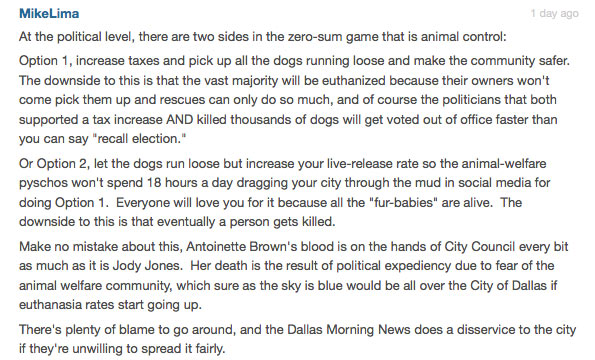
Failing Dog Attack Victims
When animal service departments are fixated on the "live release" rate, most commonly seen in No-Kill cities, such as Austin, the priority of public safety takes a nosedive. These results can appear in different areas, including a rise in dog bites, a rise in loose and aggressive dogs and failing dog bite victims. All of which run counter to the priorities of a well-functioning animal control department. The "live release" numbers fixation can also lead to adopting out dangerous dogs.
One Dallas mauling victim, Nancy Lewis, recently shared her story. DAS never contacted her after she was attacked in September 2014. Then 1.5-years later, a few weeks before Antoinette's death, DAS called her because they are now investigating another attack involving the same dogs. During the call, DAS dropped the "bombshell" that one of the dogs had severely bitten a woman in 2012. Lewis never had this information, which is make or break in the one bite state of Texas.
Along with the many other protocol breakdowns, DAS' failure to supply a dog attack victim with a bite report indeed indicates systemic problems.
It's been 20 months since she was attacked and Lewis still has been unable to obtain her bite report from DAS. Under the open records act, she was provided a single page; it is a brief EMS Firefighter report that references the date, location, that the status became "closed" after 18-hours and a few other details. It is not a bite report; it is an EMS Firefighter reference to the attack. How many other victims has DAS failed to provide a bite report to, which is vital for civil a lawsuit?
We are in contact with Lewis and will keep you posted as that protocol violation unfolds.
05/10/16: Cyclical Complaints
The household and dogs involved in the brutal mauling death of Antoinette Brown had a long history of complaints with Dallas Animal Services. In fact, the history is extremely disturbing, but no more disturbing than the "vicious dog owner loop" that plagues most jurisdictions. The dogs' owners are cyclical, repeat offenders. They are the very type of grossly irresponsible dog owners -- about 2% of all dog owners -- that the system is allegedly supposed to catch, but often does not.
The Dallas Police Department issued an update explaining this extensive history. Since 2014, the owners have made 20 dog surrenders after violations and attacks. At least 3 have resulted in euthanasia, another 7 will too after this investigation. What is true about the "vicious dog owner loop" -- after the dog is declared vicious and put down, the owner gets a new one and repeats the whole process -- is usually true with animal neglect offenses too. There are no laws in place to stop it.
On May 5, 2016, Dallas Animal Services reviewed the address and found previous 311 calls regarding loose dogs complaints. Seven dogs were found living at the location and Dallas Animal Services was able to take 6 dogs into possession on May 6, 2016. The seventh dog was located on May 9, 2016 and quarantined. Between July 2013 and August 2014, records indicate residents made 10 calls regarding this location. In 2014, the owner surrendered ten dogs after repeated visits and violation notices from Dallas Animal Services. In September 2015, neighbors reported an attack in progress, resulting in five citations being issued and surrendering of three more dogs that were subsequently euthanized. Dallas Animal Services issued an additional 16 citations on May 6, 2016.
The owners gave permission on May 6, 2016 for Dallas Animal Services to take custody of the animals. These dogs were processed for evidence to confirm whether they were involved in the attack on Ms. Brown. Dallas Police have submitted the evidence to Southwest Institute of Forensics Science2 and are awaiting the results of testing. - Dallas Police Department
For readers who are not used to seeing this part of the broken system, it is a pretty common reality. If your next question is: Why can't we sue animal control departments in these cases? Then we direct you to: The Plight of a Mauled Postal Carrier, an Attempt to Sue Animal Control and the Progression of a Criminal. This blog post dives deep into the governmental immunity issue, a legal concept that one needs a grasp of when considering this lawsuit question.
Texas Felony Dog Attack Law
The Dallas Police blog post also indicates that they plan to pursue these owners under the Texas felony dog attack statute, also referred to as Lillian's Law. This may be the first time Dallas County authorities have pursued under the statute. In 2014, we saw Harris County (Houston) prosecutors finally embrace it for the first time. Comal County prosecutors did too after a fatal pit bull mauling. Texas case law continues to build as more and more cases are successfully prosecuted under it.
Given the history of these owners and their aggressive dogs, it seems Dallas County prosecutors can build a solid case against them. The dogs suspected of killing Antoinette are currently being DNA tested to see if it matches DNA found on the victim. Obvious blood evidence was long gone by the time the dogs were seized by authorities 4 days later. That is a serious time gap. Dallas City Manager A.C. Gonzalez addresses this in a letter published by NBC 5 Dallas-Fort Worth.
I’ve been meeting with Dallas Police Department (DPD) and Dallas Animal Services (DAS) leadership to review this situation. We have identified several communication gaps as the events of the last week unfolded. DPD did not immediately notify DAS about the attack, which is why DAS responded over the next few days to subsequent calls for loose dogs as routine calls.
After DPD informed DAS managers about the attack Thursday evening, the two departments coordinated a response for Friday morning, at which time the suspected dogs were taken into custody, where they remain. In addition, we did not properly identify a pattern of behavior that was developing and would have given us an opportunity to bring DPD into the loop sooner to investigate for criminal activity. We are fixing these gaps by changing procedures so that first responders arriving to the scene of a dog attack will immediately notify DAS. Technology changes are also in process to further help with this communication. - Dallas City Manager A.C. Gonzalez
Read the city manager's letter in full | View timeline of "gaps"
05/09/16: Son Confirms Death
A woman savagely attacked by a pack of dogs in southern Dallas last Monday has died. NBC 5 Dallas-Fort Worth reports the son of 52-year-old Antoinette Brown, Laquan, confirmed her death to them. Earlier today, the son said the family would be ending life support this afternoon. The victim's daughter, Matisha Ward, shared news of her mother's death with Dallas City Council member Tiffinni Young. "She went down fighting ... She is in a better place," Ward told Young.
The city has been struggling with a loose and stray dog problem for years. In October, the city began a new initiative to tackle it. Unfortunately, these efforts were not enough to prevent a savage pack attack that resulted in a woman's death. Dallas city leaders have promised a new approach to the problem. "The priority has not been high enough, ok, obviously," Mayor Mike Rawlings said. "Progress is great, but we were in a deep hole and we have a long way to go."
05/09/16: Mauling Victim Clings to Life
Dallas, TX - On Saturday, The Dallas Morning News reported that 52-year old Antoinette Brown was brutally attacked by a pack of dogs in the 3300 block of Rutledge Street, a southern Dallas neighborhood. She was bitten over 100 times and placed into a medically induced coma. The attack occurred Monday morning. Police did not confirm this until 5 days later. Police Chief David Brown Tweeted the delay was due to capturing the dogs before the owner could get rid of them.
“They ate her like they was eating a steak.” - Barbara Brown, the victim's mother
There was more to the Tweet exchange between Police Chief Brown and The News reporters as well. See the full exchange here. Chief Brown fired back at both reporters, "Question for you...why was it necessary to include the victims criminal history in the article?" By the time DogsBite.org read the article, The News had removed this language. Thank goodness for editors. Antoinette is horrifically injured -- degloving injuries and worse. Her family does not know if she will survive.
"Bandages cover the places where the dogs peeled off her skin, exposing muscle and tendons. A doctor told her family that he stopped counting at 100 bite wounds," states The News. Antoinette is currently hospitalized at Baylor Medical University Center at Dallas. Her mother, Barbara Brown, told The News that her daughter's medical condition is fragile and currently in limbo. “We’re in a box,” Barbara said. “We can’t go forward and we can’t go backwards and we can’t go sideways."
Loose Dog Problem
Since 2014, the loose and stray dog problem in southern Dallas has been a growing concern. In October 2015, the city began increasing patrols in targeted neighborhoods to combat this problem. The initiative was set to run through March 2016, and by that time, Dallas Animal Services (DAS) would have hired an additional 49 officers to help rein in the problem. By April 25, 2016 the program was running at full tilt -- just 3-weeks before Antoinette was nearly mauled to death.
Metrics released on April 25 showed a significant improvement. By adopting community policing and hot-spot policing tactics -- primarily in the southeastern neighborhoods -- citations for loose dogs had risen higher than any previous fiscal year. Also by this time, DAS had started to broaden out from the targeted hot-spot areas to reach more southern neighborhoods affected by the loose and stray dog problem. Despite the city's commitment, a catastrophic injury pack attack occurred.
Latest Developments
The latest developments include Chief Brown's indication the dogs' owner could face possible criminal charges. Police have not released breed information. The six suspected dogs were captured by DAS on Friday. WFAA reported Sunday that DAS went door-to-door on Mother's Day and set up new traps for "true" stray dogs. As Esteban Rodriguez with Dallas Animal Services states, "the majority of these dogs are owned and people just have to become responsible."
On Monday, Antoinette's son told NBC 5 Dallas-Fort Worth they will be taking her off life support.
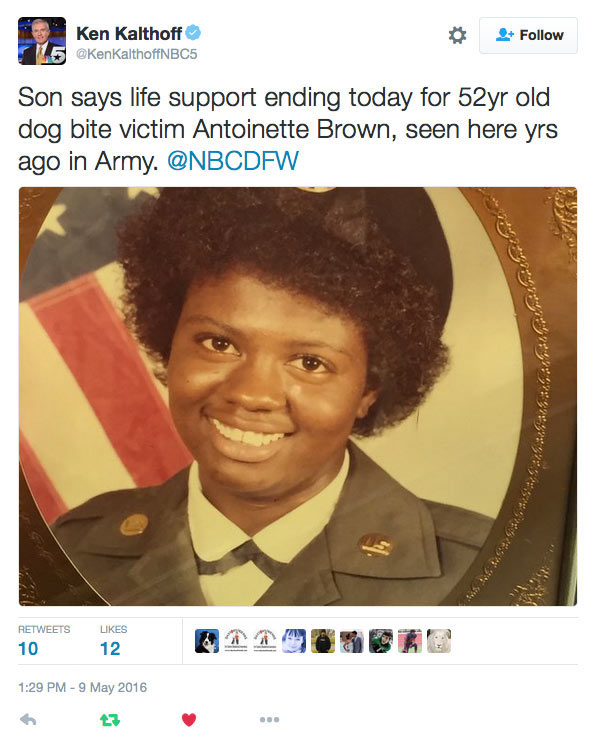

Related articles:
05/20/14: The Plight of a Mauled Postal Carrier, an Attempt to Sue Animal Control and...
08/29/13: East Texas Woman Severely Mauled by Pit Bull at 'Dog Friendly' Private RV Park



